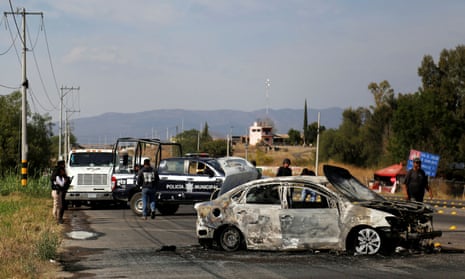Mexico’s homicide rate raced to a new record in March, as violence raged even as Covid-19 spread across the country and authorities urged the population to stay home and practise social distancing.
Mexico registered 2,585 homicides in March – the highest monthly figure since records began in 1997 – putting 2020 on track to break last year’s record total for murders.
The surge in killings comes as federal and state officials put resources into containing the Covid-19 crisis and confront the prospect of an already sluggish economy falling even further – potentially deepening the misery for the more than 40% of the population living in poverty.
“It’s business as usual [for drug cartels] with a risk of further escalation, especially if at some point the armed forces are called away for pandemic control,” said Falko Ernst, senior Mexico analyst at the International Crisis Group.
Violence has flared throughout the country, but it has been especially intense in the central state of Guanajuato, where criminal groups have battled over lucrative territories rife with theft from pipelines.
The bloodshed has hit shocking levels in the city of Ceyala – home to a major automotive manufacturing plant – with gunmen engaging security forces in shootouts, blockading streets and torching businesses.
Francisco Rivas, director of the National Citizen Observatory, which monitors security issues, attributed the increasing violence in Guanajuato to the fallout of the federal government trying to stamp out petrol theft.
The crackdown weakened the local Santa Rosa de Lima cartel, Rivas said, prompting the rival Jalisco New Generation cartel (CJNG) to move in and attempt to take its territory.
Other causes for rising violence, Rivas said, include growing pains with a new militarised police known as the national guard, the lack of a federal strategy and cutting the security budget to its lowest level in 20 years.
“We’re seeing violence hitting its peak and we’re left asking, ‘who’s going to stop it?’” Rivas said.
Quick GuideMexico's evolving war on drugs
Show
Calderón sends in the army
Mexico’s “war on drugs” began in late 2006 when the president at the time, Felipe Calderón, ordered thousands of troops on to the streets in response to an explosion of horrific violence in his native state of Michoacán.
Calderón hoped to smash the drug cartels with his heavily militarized onslaught but the approach was counterproductive and exacted a catastrophic human toll. As Mexico’s military went on the offensive, the body count skyrocketed to new heights and tens of thousands were forced from their homes, disappeared or killed.
Kingpin strategy
Simultaneously, Calderón also began pursuing the so-called “kingpin strategy” by which authorities sought to decapitate the cartels by targeting their leaders.
That policy resulted in some high-profile successes – notably Arturo Beltrán Leyva, who was gunned down by Mexican marines in 2009 – but also did little to bring peace. In fact, many believe such tactics served only to pulverize the world of organized crime, creating even more violence as new, less predictable factions squabbled for their piece of the pie.
Under Calderón’s successor, Enrique Peña Nieto, the government’s rhetoric on crime softened as Mexico sought to shed its reputation as the headquarters of some the world’s most murderous mafia groups.
But Calderón’s policies largely survived, with authorities targeting prominent cartel leaders such as Sinaloa’s Joaquín “El Chapo” Guzmán.
When “El Chapo” was arrested in early 2016, Mexico’s president bragged: “Mission accomplished”. But the violence went on. By the time Peña Nieto left office in 2018, Mexico had suffered another record year of murders, with nearly 36,000 people slain.
'Hugs not bullets'
The leftwing populist Andrés Manuel López Obrador took power in December, promising a dramatic change in tactics. López Obrador, or Amlo, as most call him, vowed to attack the social roots of crime, offering vocational training to more than 2.3 million disadvantaged young people at risk of being ensnared by the cartels.
“It will be virtually impossible to achieve peace without justice and [social] welfare,” Amlo said, promising to slash the murder rate from an average of 89 killings per day with his “hugs not bullets” doctrine.
Amlo also pledged to chair daily 6am security meetings and create a 60,000 strong national guard. But those measures have yet to pay off, with the new security force used mostly to hunt Central American migrants.
Mexico now suffers an average of about 96 murders a day.
President Andrés Manuel López Obrador said on Friday that a drop in violence had been expected towards the end of March when coronavirus cases had started increasing in Mexico, “but it didn’t turn out like that.”
López Obrador came to power promising to solve Mexico’s security woes by tacking what he considered the root causes of crime: poverty and corruption. But the strategy has so far failed to rein in the violence.
“The [anti-crime] strategy isn’t a strategy,” said Rivas. “The national guard isn’t pulling its weight because building an institution is difficult and expensive. Budget cuts to public security have been brutal. These all have serious effects.”
The president stirred further outrage during a visit to Sinaloa state on Sunday, when he stopped to greet the mother of convicted cartel kingpin Joaquín “El Chapo” Guzmán – breaking with social-distancing protocols to shake her hand.
López Obrador downplayed the greeting as little more than a courtesy to a mother who hadn’t seen her son in five years, but his comments prompted outrage from families of victims of violence, who say he has failed to extend the same courtesy to them.
“For society and victims, who have been having a hard time meeting or being listened to by the president,” Ernst said, “it’s a heavy slap in the face.”
